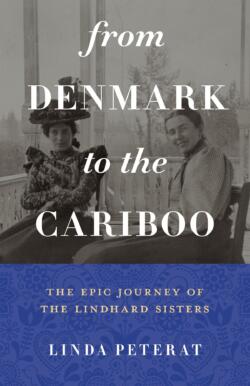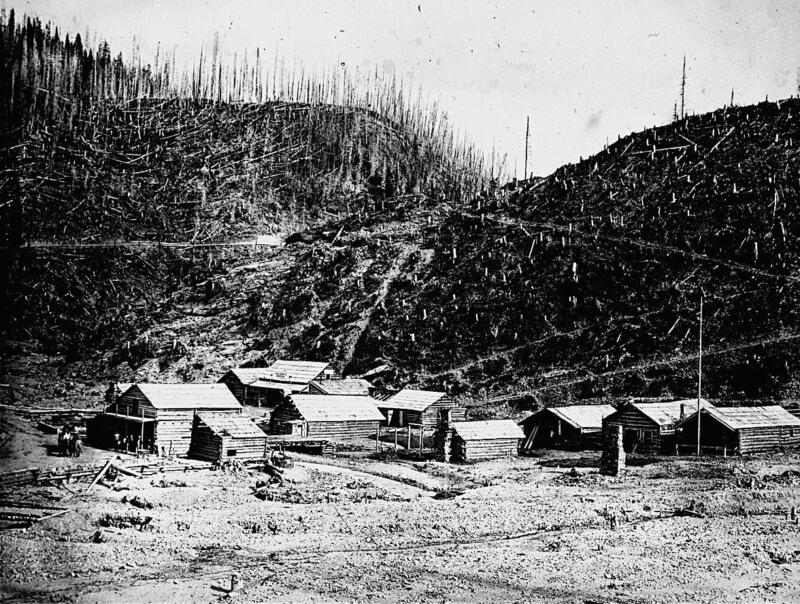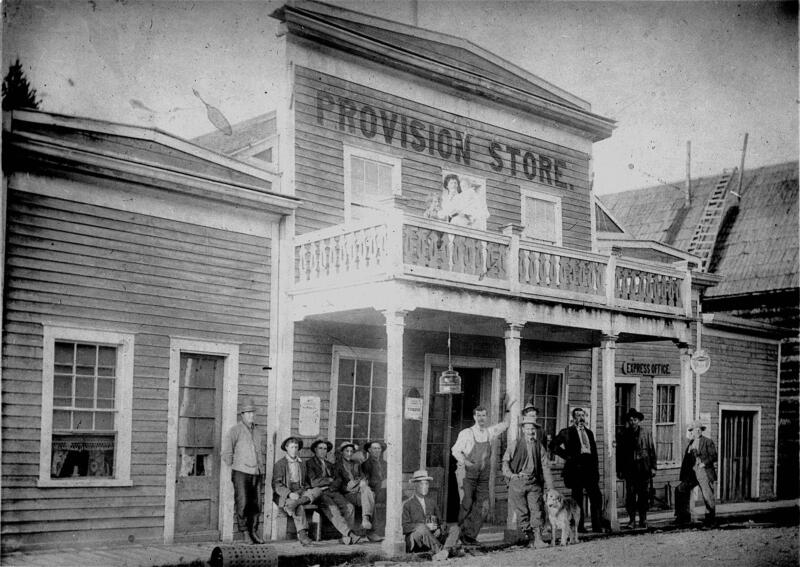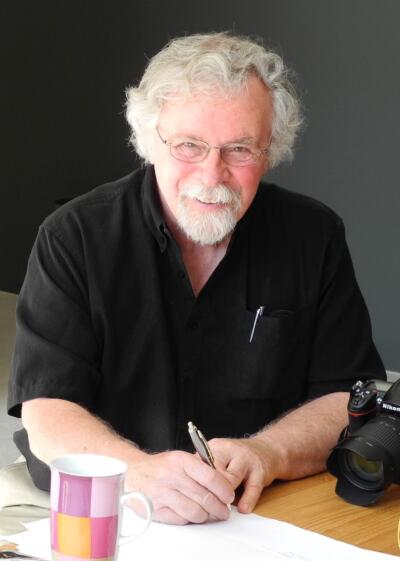1683 The Cariboo sisters
From Denmark to the Cariboo: The Epic Journey of the Lindhard Sisters
by Linda Peterat
Victoria: Heritage House Publishing, 2022
$26.95 / 9781772033939
Reviewed by Richard Thomas Wright
*
 If one visits today’s centre of the Cariboo gold fields in Barkerville it would be easy to come away with the understanding that Williams creek and its towns of Richfield, Barkerville, and Cameronton were the only towns on the north slope of the Cariboo Mountains; and that only about two dozen people made up the population.
If one visits today’s centre of the Cariboo gold fields in Barkerville it would be easy to come away with the understanding that Williams creek and its towns of Richfield, Barkerville, and Cameronton were the only towns on the north slope of the Cariboo Mountains; and that only about two dozen people made up the population.
By necessity — from a lack heritage funding — the Barkers, Camerons, Masons, and Daly and several others Caribooites have become the de facto focus of interpretive attention. Since Barkerville’s interpretation began in the mid 1980s there has been a tendency to focus on the same characters year after year.
Linda Peterat breaks that perception by introducing the reader not only to another creek, Lightning instead of Williams, and other towns, Van Winkle, Stanley, Soda Creek, and roadhouses like 150 Mile, but also a wealth of new characters and families: Lindhard, Hamilton, Beedy, Bates, Dodds, and more.
From Denmark to the Cariboo: The Epic Journey of the Lindhard Sisters is a masterful piece of research, as evidenced by the detailed writing and extensive footnotes, all carefully crafted into the stories led by the three sisters, Laura, Christine, and Caroline Lindhard, and their multiple husbands, children, and cousins.


The stories focus on the later years of the gold rush, the 1870s and beyond, when the Lindhard sisters arrived in British Columbia. In some views they were the third wave or phase of the gold fields. First was the pre-Cariboo Waggon Road era, from 1862 to 1865, when travel was by foot or horseback and therefore limited the population to a hardier and one could say rougher class. With the completion of the Cariboo Road, the wheel was brought to the Cariboo Mountains, a technological shift that brought stagecoaches for passengers and wagons for a wider and more plentiful supply of goods and produce. Then, just three or four years later, in 1868, the so-called Great Fire of Barkerville drastically changed the gold towns of Williams Creek. Many folks left. Those who stayed to rebuild were locked in debt and declining gold revenues. It was new time.
Prior to this, the towns of Antler Creek and Grouse Creek to the east and Quesnel Forks to the south had already boomed and busted.
However, in the meantime, one drainage to the west, Lightning Creek, discovered before Williams Creek, had given rise to the towns of Van Winkle and later Stanley. These were the town that the Lindhards came to in the early 1870s.

Unfortunately these towns and their vibrant life have been little written of in Cariboo history, the notable exception being Bill Hong’s … And So … That’s How It Happened (1978). Hong’s work is invaluable, but he writes more about the 1930s and later than the early years [Editor’s note: please see the review of … And So … That’s How It Happened by May Q. Wong].
So Peterat’s work fills in some missing years. In doing so she also focuses on women’s roles in the gold rush commerce as pursued by the Lindhard, Beedy and Bates families. She details how Laura and Josiah Beedy (and later Laura and William Dodd), and Caroline and Joachim Lindhard were important business people at Lighting Creek, who also invested significantly in mines. Ashael Sumner Bates, Caroline’s second husband, is best known for his holdings and ranch around 150 Mile. Much of the Sugar Cane Reserve at Williams Lake is on land Caroline sold after his death. Her extensive research from broad sources paints a new picture of the history of commerce in this western gold creek.


While focused on the 1870s and 80s, Peterat does mention in passing the women of the early years and those of the demimonde: the hurdies, saloon keepers, and prostitutes, and the wives of miners. Early on she indicates that marriage was women’s sole choice — with which these early women might argue. Indigenous women are only mentioned in passing, or as the early “country wives” of miners and merchants in families including the Dunleavys, Masons, Nasons, Sellers, and Bateses. She does, however, show how the legal system, particularly around estates, was changing to enfranchise women — thanks in part to Judge Matthew Begbie — for both First Nations country wives and married settler women.

On the business end, the book is a wealth of riches with fascinating detail on how these women became wealthy through investments and, in many unfortunate cases, as widows multiple times over. Caroline, for example buried three husbands and was tied up in court for decades. The Lindhard sisters lost several children, as was common at the time. Their successes, though, show how they learned the lay of the land, not only how to survive but to thrive in adversity.
Few other works of BC history and biography can match the stories in From Denmark to the Cariboo for the role of settler families, and especially of middle and upper class women.
When I first saw this book I was eager to jump in. I knew of the Lindhard, Beedy, and Bates families from previous research, and James Hamilton I recognized as one of the BX’s top whips who later began a partner.
Unfortunately the book proved not always to be an easy, engaging read. The foremost problem is the decision to divide the text into three major sections, each centred on one of the Lindhard sisters. This causes repetition with the same facts, dates, and names being repeated three times, which makes for difficult and confusing reading. The author’s propensity to mention the death of a character and then backfill her or his earlier biographical information, a problem known to editors as “receding chronology,” is also confusing because the reader has assumed the subject’s life is over and done, only to be presented with material that belonged earlier in the narrative. In many cases the book is hindered, and reading made awkward, by needless repetition of facts and details tangential to the storyline. One is reminded of the instructions of a writing coach who taught that there are three kinds of facts: need to know, nice to know, and pain-in-the-ass to know. The latter slow the pace of the book to a crawl in some spots. It could have been improved by a copy editor’s heavy blue pencil to correct the overuse and indeed the misuse of the common comma, which often truncates and confuses the meaning of a sentence.
Some might take umbrage with the title The Cariboo. It is oft-debated but generally accepted that it should read Denmark to Cariboo.

Those annoyances aside, the book is a valuable piece of BC history. One theme I was made particularly aware of is how important San Francisco was to Caribooites wanting to escape northern winters, and the society they built in that attractive southern city. Also, given the later development of escapist communes in BC in the 1970s and 80s, it was fascinating to read of Christine Lindhard Hamilton’s years of membership and financial support of the Koreshan Unity Commune of Chicago and Florida, almost 100 years prior to our more recent hippy communes.
The towns Peterat focuses on have, with the passage of time, disappeared. Van Winkle was first washed away by hydraulic mining and is now the site of a large placer operation. You can hike the area, being careful of open shafts, and find the detritus of a hundred years, but only Bill Hong’s old cabin remains. Stanley too has gradually succumbed to desertion, harsh winters, and vandals. Only one building remains. Down the road, though, the grave markers of some of the characters endure. Laura’s husband Josiah Beedy is here, as is Yoachim Wilhelm Lindhard, Caroline’s husband (and cousin), both carefully tended in the Stanley cemetery by the Friends of Barkerville and Cariboo Goldfields Historical Society.
With From Denmark to the Cariboo: The Epic Journey of the Lindhard Sisters, Linda Peterat has done history a favour with her careful and complete history of a hitherto undocumented time and a cast of virtually unknown yet vital characters.
*

Richard Thomas Wright is a British Columbian writer and photographer, a playwright and filmmaker. He has written 22 books, a dozen plays and produced some 40 films. With a particular interest in BC’s Cariboo gold rush, Wright’s Barkerville and the Cariboo Goldfields (Heritage House) is now in its 5th edition (2013). He is also author of The Overlanders (1985), a study of the gold seekers who travelled the land route from Canada to the gold fields. He was the founding Chair of the Friends of Barkerville and Cariboo Historical Society in 1984, had served on the the BC Heritage Trust and the Barkerville Trust. As a revisionist historian he produced two treks with camels, deconstructing the “Cariboo Camel” myth for segments on National Geographic Today and On The Road, CBC, and has collected BC folksongs for two music CDs. Starting in 2004 he and partner Amy Newman operated the Theatre Royal in Barkerville, where he produced, directed, and wrote ten plays including The Unquiet Grave, Westering Man, and Diller’s Luck. During this time he and Newman began the Bonepicker.ca project, a film series on Vimeo that “picks at the bones of history.” Several of his films have won international awards. In 2019 Newman and Wright left Barkerville and the Theatre Royal for other projects. Wright is a consultant on “art in heritage” issues and leads the Cariboo Waggon Road Restoration Project for the New Pathways to Gold Society. See his work also at Winter Quarters Productions.
*
The British Columbia Review
Publisher and Editor: Richard Mackie
Formerly The Ormsby Review, The British Columbia Review is an on-line book review and journal service for BC writers and readers. The Advisory Board consists of Jean Barman, Wade Davis, Robin Fisher, Barry Gough, Hugh Johnston, Kathy Mezei, Patricia Roy, Maria Tippett, and Graeme Wynn. Provincial Government Patron (since September 2018): Creative BC. Honorary Patron: Yosef Wosk. Scholarly Patron: SFU Graduate Liberal Studies.
“Only connect.” – E.M. Forster